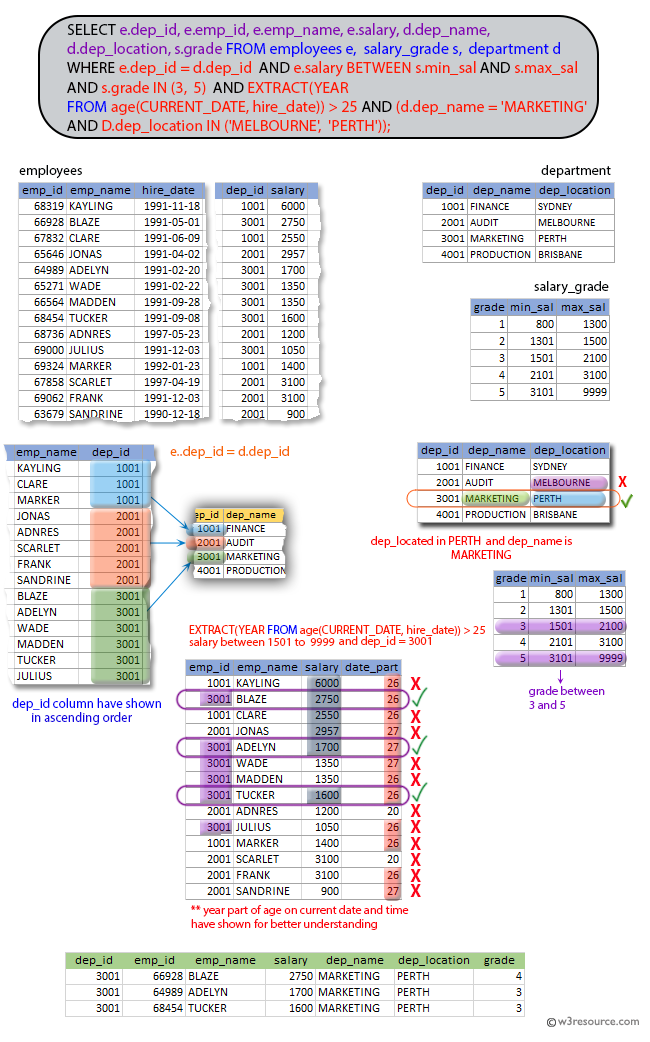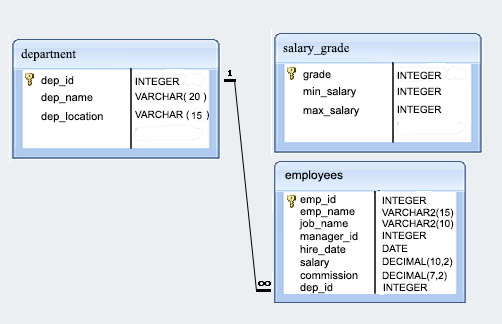SQL Exercise: Employees location, grade, and experience over 25 years
[An editor is available at the bottom of the page to write and execute the scripts.]
62. From the following table, write a SQL query to find the employees of MARKETING department come from MELBOURNE or PERTH, are in grades 3 ,4, and 5 and have at least 25 years of experience. Return department ID, employee ID, employee name, salary, department name, department location and grade.
Pictorial Presentation:

Sample table: employees
Sample table: salary_grade
Sample table: department
Sample Solution:
SELECT e.dep_id,
e.emp_id,
e.emp_name,
e.salary,
d.dep_name,
d.dep_location,
s.grade
FROM employees e,
salary_grade s,
department d
WHERE e.dep_id = d.dep_id
AND e.salary BETWEEN s.min_sal AND s.max_sal
AND s.grade IN (3,4,
5)
AND EXTRACT(YEAR
FROM age(CURRENT_DATE, hire_date)) > 25
AND (d.dep_name = 'MARKETING'
AND D.dep_location IN ('MELBOURNE',
'PERTH'));
Sample Output:
dep_id |emp_id |emp_name |salary |dep_name |dep_location |grade | -------|-------|---------|--------|----------|-------------|------| 3001 |66928 |BLAZE |2750.00 |MARKETING |PERTH |4 | 3001 |64989 |ADELYN |1700.00 |MARKETING |PERTH |3 | 3001 |68454 |TUCKER |1600.00 |MARKETING |PERTH |3 |
Explanation:
The said query in SQL that selects the department ID, employee ID, employee name, salary, department name, department location, and salary grade of employees who work in the Marketing department located in either 'MELBOURNE' or 'PERTH', whose salary falls within the range of salary grades 3, 4, or 5, and whose hire date is more than 25 years ago from the current date.
The query joins the 'employees', 'salary_grade', and 'department' tables that returns rows that have a matching record in all three tables. The 'employees' and 'department' tables are linked based on the dep_id column.
The "WHERE" clause filters the results to employees whose department name is 'MARKETING' and department location is either 'MELBOURNE' or 'PERTH'.
By comparing the employee's salary to the "min_sal" and "max_sal" columns in the "salary_grade" table, the "BETWEEN" operator filters the results to employees whose salaries are within the salary grade range.
It further includes those employees whose hire date is more than 25 years ago from the current date using the "age" and "EXTRACT" functions. The "age" function calculates the difference between the current date and the hire date, and the "EXTRACT" function extracts the year value from the result of the "age" function.
Go to:
PREV : Employees with location, salary range, and joined in 91.
NEXT : List the employees who are senior to their own manager.
Practice Online
Sample Database: employee

Have another way to solve this solution? Contribute your code (and comments) through Disqus.
What is the difficulty level of this exercise?
Test your Programming skills with w3resource's quiz.
